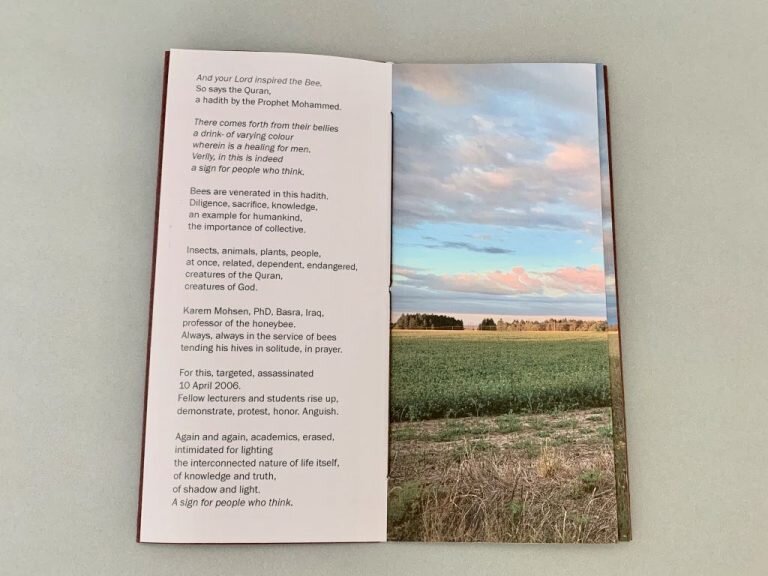Last March, when journeying in Arizona, I had planned on visiting four artists in the Tucson area. Unfortunately, as my excitement grew and planned visits were imminent; Covid-19 shocked our familiar world and everyone went into lockdown. Bleak days.
That was five months ago, and the pandemic is still part of our lives. So, as mentioned in my previous post, my studio visits will continue virtually while we all get used to the new normal. One of the studio visits planned was with Laura Russell who was at her winter house in Arizona. Laura is a photographer and book artist who creates hand-bound, limited-edition artist books that incorporate photographs of our urban landscape and tell a story about our culture and our communities. Laura was the owner of 23 Sandy Gallery, a book art gallery in Portland, Oregon, from 2007 to 2020. 23 Sandy Gallery is presently owned and operated by Erin Mickelsonan and is an online gallery. Laura is extremely excited about the future and finding studio time for her own books.
© 2020 Laura Russell. Laura’s studio in Portland, Oregon.
© 2019 Laura Russell. And your Lord inspired the Bee, accordion sheet folded into four pages. 4 x 8.5 x .125 inches. Extends out to 15.25 inches. An edition of 25, signed and numbered.
© 2019 Laura Russell. And your Lord inspired the Bee, Pamphlet stitch cover with stepped-fold accordion interior. Archival digital prints. Mohawk Superfine Text and Canson Mi Tientes papers.
Book One of Laura’s Show & Tell Chapbook Series created for the Shadow and Light photography project. A project of the Al-Mutanabbi Street Starts Here Coalition curated by Beau Beausoleil. This book honors Karem Mohsen, PhD lecturer at the Department of Agriculture, College of Agronomy, Basra University, Iraq. I learned from Beau that Dr. Mohsen was killed on 10 April 2006. He worked in the field of honeybee production. Lecturers and students called for a demonstration to protest his assassination.
© 2015 Laura Russell. Bold Heart, carousel book in an edition of 25. Archival pigment prints on Red River Polar Matte paper. Cover: binders board covered with handmade paper that looks like animal hide made by Andrea Peterson at Hook Pottery Paper. Carousel is five panels/pages. The book is 4 w x 6 h x .75 d inches closed and 26 inches long when extended. Displays as carousel at 8 x 8 x 6 inches.
Bold Heart is the second in a series of books about Diana (aka Artemis), the Goddess of Hunting. Photographs of Diana (Laura’s niece Hanna poses for this project) with her bow and arrows and her prey are paired with photographs of deer hidden in the woods. Diana was not only the Goddess of Hunting, but she was also the protectress of teenage girls, making Hanna the perfect model. Diana cherished the traits that made her a strong, independent woman — which Hanna is already destined to be. Forever young, Diana defended untamed nature, high mountains and sacred woods. In addition, she was a protector of women and childbirth and the Goddess of the Moon.
© 2018 Laura Russell. Take Me, I’m Yours, structure: Hedi Kyle Flag book. 20 original photographs by the artist. Archival pigment prints on Red River Polar Matte and Moab Lasal papers.
© 2018 Laura Russell. Take Me, I’m Yours, spine: black Fabriano Ingres paper. 8.5 x 4 x 1 inches closed. Accordion extends out to 40 inches. Edition of 25.
© 2018 Laura Russell. Take Me, I’m Yours.
Many years ago this artist placed a singles ad in Denver’s alternative weekly newspaper. The headline read, “Work Hard, Play Hard” and now this book celebrates 25 years of happy marriage thanks to a fun advertising experiment. In a bit of whimsy, image and text play off each other to create irreverent pairings of singles pick-up lines with intimate portraits of abandoned furniture that can be found cast aside like a bad romance on city streets everywhere. Twenty Polaroid-style photographs are paired with text highlighting the becoming features of the lonely furniture. The 80’s-style looker says, “Single white sofa, mature, well-endowed, seeking free love in warm, cozy, dry home.” The teal velvet slipper chair says, “Me: clean, curvy, cushy, velvety, dove-tail joints. Single and ready to mingle.” This limited-edition artist book utilizes Hedi Kyle’s flag book structure to mimic a local bulletin board that might have been used for advertising in the good old days before the internet.
© 2013 Laura Russell. Anything Helps, pamphlet stitch booklet sewn into vintage billfold wallet plus six cards telling the stories behind the photographs that fit inside credit card slots. Turkish map fold center spread with pop-out sign.
Anything Helps is a limited edition artist book surveying the cardboard signs used by panhandlers and homeless people. We have all seen these folks on street corners holding hand-scrawled cardboard signs. They can be found on city intersections, downtown corners and highway off ramps in cities large and small across our great county. It is so easy to merely drive by and avert our eyes as we pass a homeless person. It is my hope that this book will make us stop and reflect upon the lives we look at every day but never really see.
© 2013 Laura Russell. Anything Helps, is an artist’ book in an edition of 25 with 32 pages; archival digital printing on Red River Polar Matte paper. Dimensions when closed: variable, approx 4.25 x 4.5 x .5 inches.
I will miss Laura’s integrity, friendly business flair, but I’m happy that she is finding time to create her lovely artists’ books. Good luck in all future creative endeavour. Hope to meet in real time again. Good luck.
If any of you would like to show me your studio space, and your work, please email me for details.
© 2020 Louise Levergneux. Paolo Soleri’s windbells being created in the art studio at Arcosanti in Arizona.



































